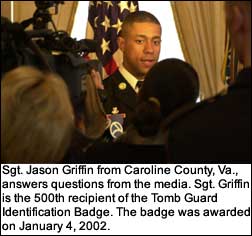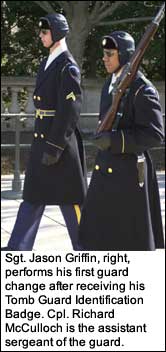Story by Sgt. Jamelle Colbert
Photo by Spc. Tony Knouf
MDW News Service
Arlington National Cemetery, January 4, 2002 — The legacy of vigil at the Tomb of the Unknown Soldier reached a historic milestone here today as the 500th tomb sentinel received his Tomb Guard Identification Badge. Presentations, awards and recognition followed for Sgt. Jason Griffin, the badge recipient.
The ceremony marked an occasion for past and present sentinels to celebrate the longevity of the tomb and the continued quality of soldiers selected to serve duty at the tomb.
Since the first badge was awarded on January 7, 1958, only 500 have been awarded. The Tomb Guard Identification Badge is behind only the Army’s Astronaut Badge in rarity of presentation. And as any tomb sentinel will jokingly ask, “Who joins the Army to be an Astronaut?”
In attendance for Friday’s ceremony were Major General James T. Jackson, Commanding General of the Military District of Washington, and Colonel James F. Laufenburg, regimental commander of the Old Guard.
“This marks a special day for two reasons,” Laufenburg said. “This marks a significant milestone, that is well-earned for a deserving soldier, and second this is the 500th badge to be awarded in 44 years.”
“The tomb sentinels are the most visible soldiers in our Army to the American public,” said Jackson. “Over 4 million visitors a year, to include foreign diplomats and dignitaries, are exposed to these soldiers whose level of discipline and dedication to detail is remarkable.”
Honored to receive the 500th Badge, Griffin was hesitant to take anything away from past, present or future sentinels.
“I’m no different, it’s just a milestone for the Tomb. When someone comes to pay their respects…[at the tomb]…they see us as the representatives of the Army for the United States, I just happen to be representative number 500,” said Griffin.
Carrying on the tradition that began 55 years ago, Griffin took his first walk before the public the day after the September 11th attack on America. When asked how it felt pulling guard duty so soon after the attacks, he spoke of his concern for what was going on outside the cemetery.
“I carried a lot of emotion with me at that time, when we were out there it was like we were paying respects to those who died in New York and at the Pentagon,” said Griffin.
On hand for the ceremony were Neale Cosby, badge holder #7, Richard Azzaro, badge holder #19, and Charles (Chuck) Shacochis, badge holder #39. Their tours serving at the Tomb of the Unknown Soldier span the years from 1958 to 1967. These former soldiers also make up the Officers Society of the Tomb Association; Azzaro is the current president.
“We represent the former members who could not be here,” said Azzaro. The members likened the importance of the continuity at the tomb to America’s commitment to the military and keeping traditions alive, “Being here…[at the tomb] expresses an intense commitment that has not been broken in 44 years,” said Azzaro.
“We are all still very much involved with the Tomb of the Unknowns and we are proud to have been a part of this,” said Azzaro. “Our involvement here has carried us a long way.
“You don’t fully appreciate it until you come back and see the polished look that’s been added. The dedication the troops possess is the same as it was when we were here,” continued Azzaro.
Service at the Tomb and earning the badge ushers one into a lifelong fraternity with a duty that continues after departure from the Army. The Tomb Guard Identification Badge is also the only badge known to be revoked even after leaving active duty military service.
There have been nine badge revocations since its origination in 1958. Badges can be revoked for a number of reasons — primarily revoked for bringing dishonor upon the tomb. Azzaro said he and the others who went before do not consider themselves “former” tomb guards. “We are Tomb Guards who no longer walk.”
Griffin’s objectives are more immediate.. “Right now I just want to serve honorably as a Tomb Sentinel at the Tomb of the Unknowns,” he said. “I’ve wanted to be here since high school. I tried coming here as my first assignment. It didn’t work out then, but I finally got here.”
Griffin includes completing college and earning his Expert Infantryman’s Badge in March as next on his horizon.
“These men are just as intense as we were and you still get that same chill watching them,” Azzaro said. “By the way,” said Azzaro, “We don’t refer to ourselves as former Tomb Guards, we are Tomb Guards who no longer walk.”

Michael Robert Patterson was born in Arlington and is the son of a former officer of the US Army. So it was no wonder that sooner or later his interests drew him to American history and especially to American military history. Many of his articles can be found on renowned portals like the New York Times, Washingtonpost or Wikipedia.
Reviewed by: Michael Howard

